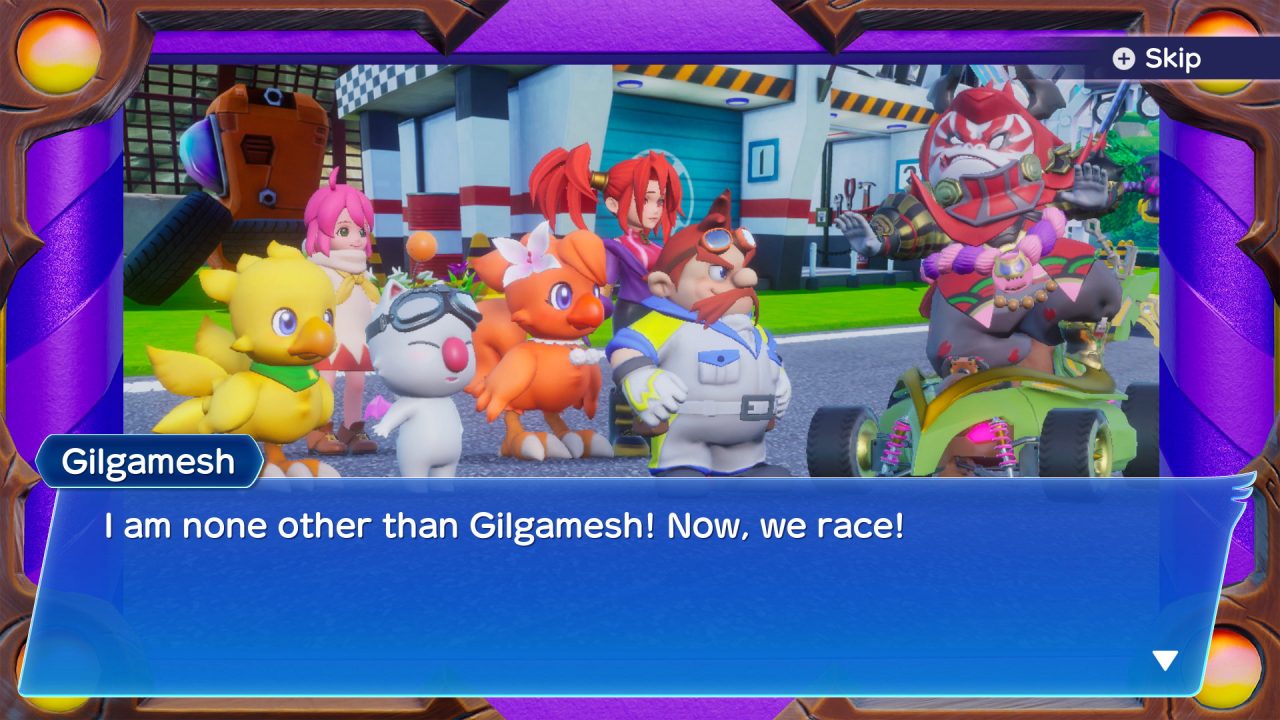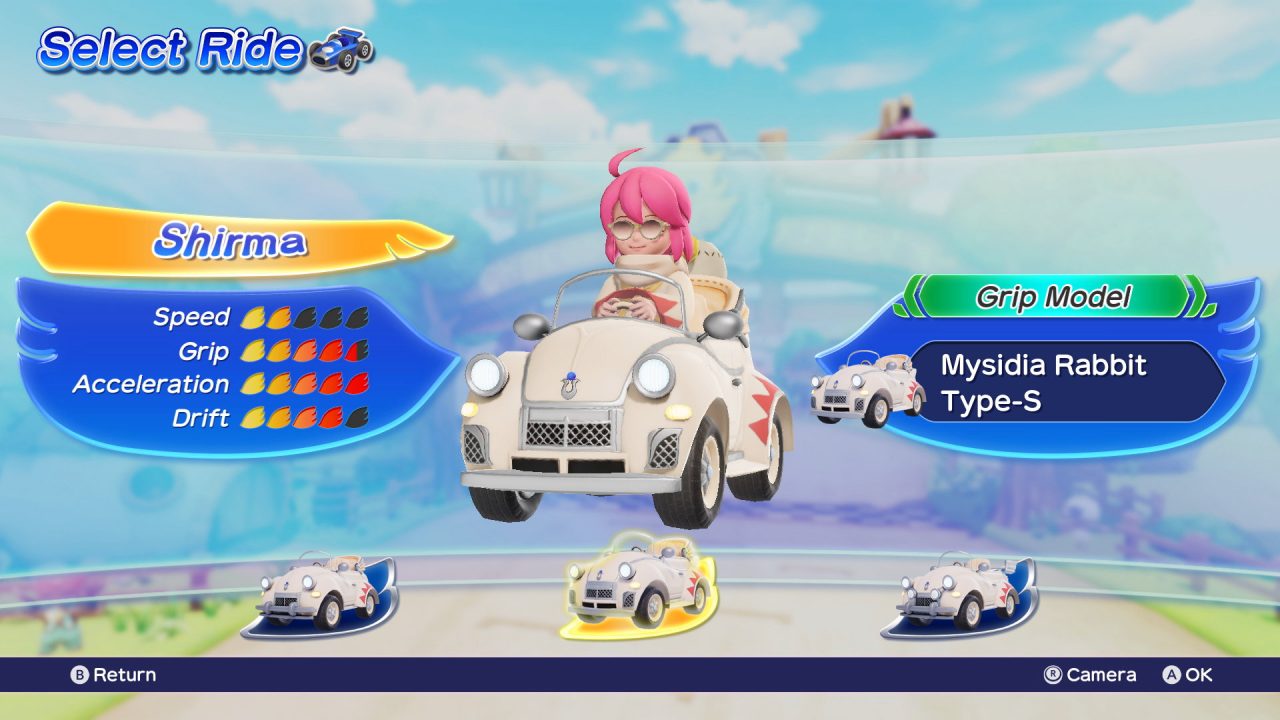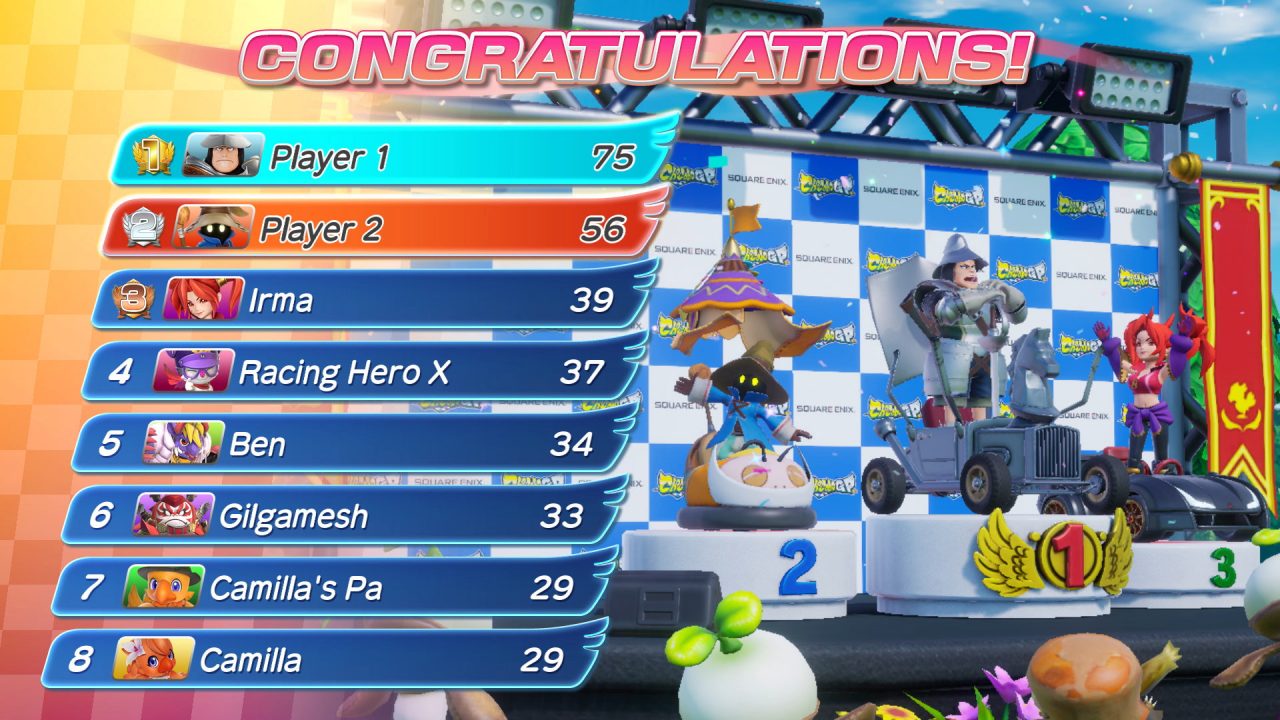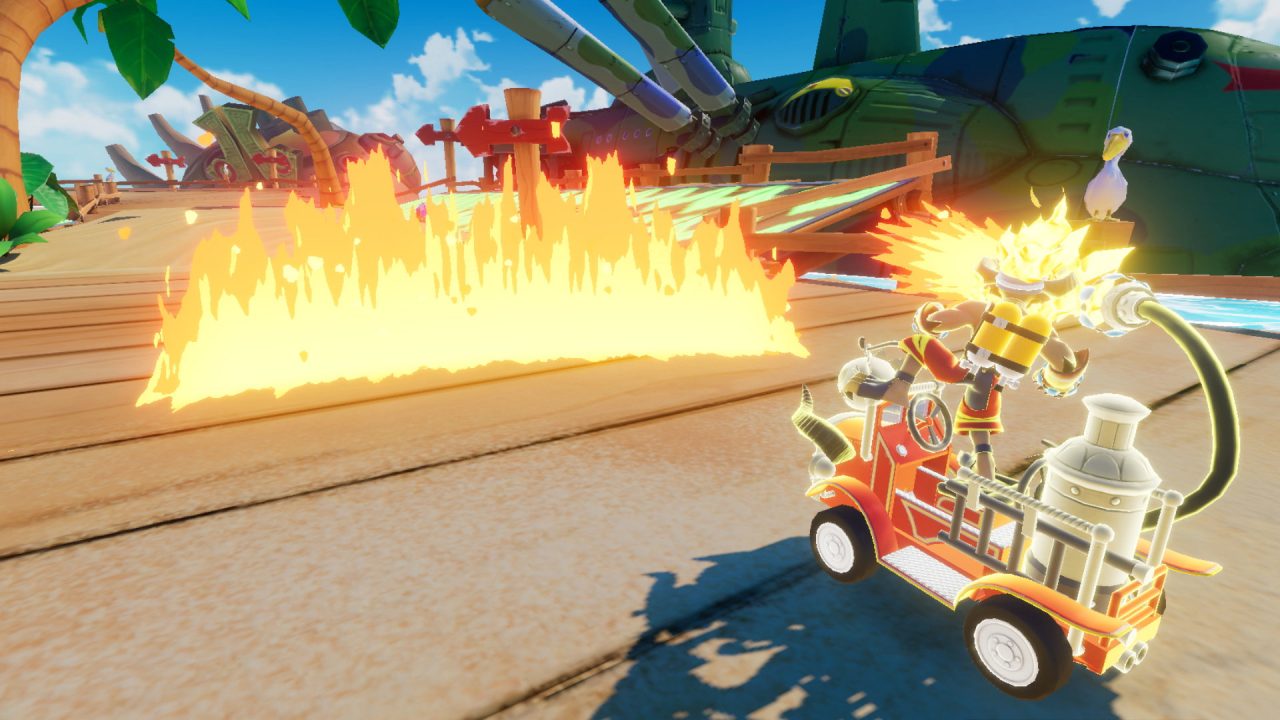What a fine day for a race…until you hear that phrase repeatedly. Despite that, any day with Chocobo GP will still make for fine racing. Final Fantasy fans haven’t heard much about racing since the original‘s release in 1999 (aside from the potential 3DS entry S-E, later canceled), likely built to compete in the potential-filled market created by Mario Kart 64. Building on the bones of Square Enix’s one-time racer, the new entry boasts some welcome improvements but remains “fine” at the moment.
Honestly, the biggest draw to this racer for players is the flavor, if nothing else. There’s a reason the original didn’t topple other racers of the time and beget a long lineage of whimsy-filled, high octane titles replete with whacky racers and exotic locales. That said, Chocobo GP is a fun spin-off from a franchise gamers know and love. While the original was often labeled an unrefined “cash grab,” it seems Square Enix incorporated feedback and made some necessary upgrades to the way this new kart-racer handles.
Players can expect to grab a racer, choose a course, and zip around themed tracks, grabbing power-ups to get an edge in the race and go for gold, unlocking new features along the way. Sounds familiar, right? Chocobo GP‘s foundation is formulaic, innovating little within a genre dominated by a certain plumber and his pals. Still, the Final Fantasy appeal does make the experience feel distinct enough to justify a possible addition to your racing library.

With a broader roster than the original nine characters and nine unlockable entrants, players have plenty of options to choose from. Now, various summons enter the fray with rides of their own alongside fan-favorite additions from Final Fantasy VI and IX, respectively. Even the infamous Hero X of Chocobo’s Dungeon fame makes their debut. When selecting your character, you need to consider their individual stats. Some have higher top speeds while others handle better, which allows you to strategize somewhat, depending on the course you’re racing on. Plus, each racer has its unique special ability that charges up throughout the race. You can charge it even faster by collecting crystals, allowing you to unleash your powers more frequently. That said, some racers have more effective abilities than others, and unlike the PS1 classic, you can’t swap them, so your mileage (ha!) may vary.
As far as customization, one new addition to the series is swapping your racer’s Ride. Back in 1999, you were stuck with what you got, from flying carpets to rocket skates. Now, each racer has three possible rides to choose from: their standard model, a grip-centric chassis, or one focused on speed. Depending on what a track calls for, you may want to swap for a different vehicle (assuming you’ve unlocked them.) You can also add cosmetic changes to your Rides with unlockable stickers and color palettes so that you can stand out on the track. Sadly, tuning your own custom Chocobo racer did not make a return.
Courses consist of fresh takes on a few of the tracks from the original and plenty of challenging new additions. Again, Chocobo Racing struggled due to poor track design, so the updates in Chocobo GP improve greatly on that. Unfortunately, clunky, technical sections often break up the flow in a race, and there are too many short tracks with simplistic layouts, leaving a lot to be desired as yet. As players progress through Story Mode, they will unlock more exciting courses offering more variety. Even then, they are essentially reconfigurations of a few existing locations, leaving replay value at a minimum with the limited initial selection. Despite this, it’s fun seeing the colorful tracks with a Final Fantasy twist and getting to visit some classic locations. You can blast across the Big Bridge from Final Fantasy V, through the gritty streets of Zozo from VI, and about IX‘s grandiose Alexandria. Still, we’re hoping Square Enix introduces more with future updates.

While playing through the Story Mode unlocks many new characters, courses, and Rides, much like Chocobo Racing did, Chocobo GP introduces a shop. With each race, you earn tickets to spend there. However, in Story Mode and the Chocobo GP, you stand to get even more, as every crystal you collect charges a gauge after each race. When it fills, you earn tickets. What’s more, specific challenges in each Story race, like finishing within a time limit or maintaining pole position with every lap, net tickets too. While some of these challenges are significant, it adds an extra layer of thrill beyond the goal of placing first, knowing that you could potentially purchase something new if you shave a few seconds off each lap. The other race modes also earn you tickets for finishing but don’t have the added challenges or gauge. Even when you’re not trying to earn extra rewards, there are accessible winning conditions besides “place first” — beating a particular character, for one — that mitigate some frustrations with Story Mode.
There is Gil to earn as well, accrued through the newly introduced Chocobo GP Mode: a 64-player online bracket tournament that starts when the first Season goes live. Mythril will also be a premium currency to buy from digital stores like the Nintendo eShop, used to obtain Prize Passes. These passes will boost earnings throughout the planned Seasons, allowing you to buy more rewards from the special offerings in the Gil Shop. While early adopters will earn a bonus of 800 Mythril (apparently the cost of one Prize Pass, though what that means in real money is anyone’s guess currently) during Season 1, the addition of a premium currency within a fully priced game seems a dubious enterprise. These prizes will unlock via a tiered level system, based on how much and how well you play in the Chocobo GP Mode in a given season. But the prizes seem unique and wondrous enough, offering new characters, rides, stickers, and hopefully courses, so it could be worth investing in (prices depending).
Now, aside from the FF theme to separate Chocobo GP from others of its ilk, Square Enix made a modest effort to infuse the mechanics with a Final Fantasy flair. You can potentially zip through Magic Eggs of differing levels (copper, silver, and gold) that contain Magicite, imbuing the driver with powerful and familiar magic spells from a broad list (obviously borrowing from other franchises). What makes Magicite unique, though, is that spells potentially level up if you run through another higher quality Magic Egg. Like the original, you can upgrade your Fire to a Firaga, making it much more effective at spoiling your opponent’s dash to victory. It’s also possible to unleash one of Final Fantasy‘s most potent spells, Ultima, with enough luck and Magic Egg collecting.

That said, the functionality and placement of Magic Eggs is frustrating. The hitboxes are seemingly awkward, and you may find yourself getting hit more often by enemy spells than your ability to cast, as you can go whole laps without getting a single power-up sometimes. Now, this may raise cries of “Git gud” and such, but if a player can regularly go a whole lap without activating an essential game mechanic, then something is off. Feeling powerless is never fun. What’s more, for lack of a better term, the “stun” duration on some of the spells and abilities severely hampers the flow of the race. Many will stop you completely for an agonizing handful of seconds as you watch your character flounder and get underway again. It’s one thing if you fall off a level, which we’ve all experienced on one rainbow-lined road or another. But in a game focused on speed and high-octane competition, bringing your ride to a complete halt for more than a few seconds, often repeatedly, is disruptive. Again, powerlessness isn’t super fun and is not great in a game geared toward a family-friendly audience.
To help you master the tracks, Square Enix made two additions that boost Chocobo GP‘s overall speed and allow you to appreciate the global improvements to track design. First, they mercifully introduced a drifting feature, allowing you to hit those tight turns and even earn a boost when you generate a Drift Spark. However, triggering a drift often feels unresponsive and is easily interrupted by other racers or by (seemingly) looking at a wall. While a useful addition, the imprecision leaves a lot to be desired. Another welcome mechanic is the Jump Tricks, which may seem familiar, allowing players to trigger a boost after going over a ramp. These two techniques help mitigate the controls feeling slightly sluggish for a modern racer.
You may not expect much from a kart racer story, but Chocobo GP did little to improve here, and it actually feels like a step down from some (at least thematically) cohesive world-building in the original entry. Despite fantastic and fun performances by the high caliber voice talent and solid localization work, the story is all over the place and bogged down by attempted fan service and hit-or-miss jokes. Characters constantly break the fourth wall for comedic effect, and familiar faces bust out notable quotes or behaviors from their original scripts in baffling, non-contextual moments that don’t land and will likely leave pre-SNES/PS1 players further in the dark, though a slew of recent remakes may remedy this. It has its moments and elicits a few chuckles as it calls out the rote tropes of Final Fantasy of yore, but it lacks the heart and cohesive journey that made Chocobo Racing‘s story at least enjoyable enough to follow.

Chocobo GP offers the expected racing options of Time Attack and local or online multiplayer. You can also create Custom race sets or take on the Series races through cups of increasing difficulty, either solo or with a friend. Unfortunately, despite the outcry at the 1999 classic, there doesn’t seem to be a plan for a “battle mode” even if it would be the most fun ever! DLC, please?
Visually, GP looks lovely, though all character and Ride designs may not land for everyone. That aside, it’s full of charm, color, and spectacle in each of its elements. While none of the courses have any breathtaking vistas or impressive set pieces, they’re still neat nods to the franchise that spawned them. Musically, the game has a great library to fall back on for arrangements, giving players blood-pumping, energized versions of everything from the rocking new “Chocobo Theme” to “Slam Shuffle” that are a delight. Unfortunately, the audio balance is off throughout the Story Mode cutscenes with volumes set to max. “Dungeon Hero X Theme” would often drown out the voicework. Also, fact: You’re going to get sick of “Choco-race” and its very literal lyrics.
The course ahead for the Chocobo Racing series still seems laden with potholes, but this new entry is still plenty of fun once you get used to it. Seasoned racers will pick it up with little issue, and it’s welcoming enough to new players, offering Beginner and Master settings (and Master does NOT pull its punches). While the current course selection is small, the vast cast of characters, Rides, and customization options to unlock may be enough to keep most players coming back for more. Plus, the promise of Seasons and the prize add-ons hopefully means more tracks to come, though that remains to be seen. For now, Chocobo GP is a fine time. It’s not doing much new with the formula, leaving the adorable, titular chocobo behind the pack of plumbers, hedgehogs, bandicoots, and their friends. Still, it does have the potential to get better and maybe toss a phoenix down on the long-dormant series for future entries.


